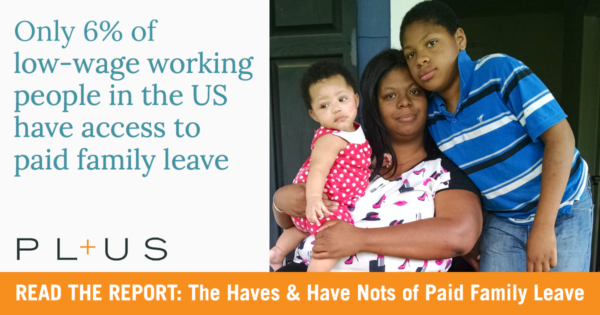The Haves and Have Notes of Paid Family Leave
Paid Leave for the United States (PL+US) has a new report that looks at the different paid parental leave offered to corporate vs frontline employees at some of the country’s largest companies – and the impact that inequity has on low-income families.
In the United States today, paid family leave is an elite benefit: 94% of low-income working people have no access to paid family leave. Millions of Americans don’t get even a single day of paid time for caregiving. 1 in 4 new moms in the U.S. is back at work just ten days after childbirth. While public discourse often focuses on income inequality, there is another critical way families experience inequality: the inability to be with their babies and families for the most important moments of their lives.
Read the PL+US report’s findings and their index of the top retailers leading the way — and the major corporate employers that are lagging behind.
CAP Report: The Pillars of Equity
A new report from the Center for American Progress, The Pillars of Equity: A Vision for Economic Security and Reproductive Justice, explores in detail the reasons that “reproductive health, rights, and justice must be integral to a successful, 21st-century economic agenda” and offers concrete policy recommendations designed to help women achieve economic security and reproductive justice in tandem.
This comprehensive policy approach “requires a policy agenda that promotes self-determination, access to comprehensive and affordable services, parenting supports, and a responsive workplace. This ensures that women—regardless of location, income status, race, sexual orientation, or age—have access to the services and resources they need in a timely, culturally competent, respectful, and affordable way that will help contribute to their economic mobility.”
“An investment in reproductive health means an investment in America’s promise of equality for all. That promise must be as adaptable and expansive as the roles women play in society. Policies and cultural norms must evolve so that women can participate freely in society and use all of their talents to strengthen families. Economic opportunities for women ensure that they can chart their own reproductive destiny and better achieve economic security. When all people are able to achieve their best economic opportunity, the entire national economy thrives and grows.”
IWPR: 5 Facts about Women and the Economy
For International Women’s Day and the “A Day Without a Woman” strikes occurring across America, the Institute for Women’s Policy Research has compiled together 5 important facts to know about women and the economy:
1. Hispanic women will wait 232 years for equal pay, if current trends continue.
2. Equal pay would cut poverty by more than half for working women and grow the U.S. economy.
3. Job Segregation keeps 1 in 4 working women in traditional care, serving, and cleaning roles with lowest pay.
4. Women account for only 1 in 3 workers in good, growing, middle-skill occupations.
5. A national paid leave policy could help young working mothers, a group least likely to have access to leave.
Read more from IWPR about these economic barriers women continue to face in our economy.
New Survey Shows Strong Support for Paid Family Leave Fund
Paid family leave, paid sick leave, and affordable childcare: these aren’t political talking points, they’re the sort of public policies that will allow working families – including Unmarried Women and the Rising American Electorate – to succeed in today’s economy. A new poll commissioned by the Work Family Strategy Council shows that these policies enjoy overwhelming support with American voters: “By a nearly 2-1 margin, 61 percent of voters in these states, which include Iowa, support the creation of a national paid family and medical leave fund, 69 percent support a paid sick days law, and 57 percent support increasing access to high-quality, affordable child care, according to the survey. Among Iowans polled, 63 percent said they support a national paid family and medical leave fund, while 25 percent said they oppose it.”
Other critical takeaways from the poll include:
- “Overall, a majority of voters in the 15 states believe a national paid family and medical leave fund would make the country better off, while only 26 percent think it would make the country worse off.”
- “Voters across states say they favor a law that would create a national paid family and medical leave fund: 61 percent say they favor such a law, 44 percent say they strongly favor one, while 34 percent are opposed.”
- “A strong majority of people surveyed say they face challenges when managing job, family and personal responsibilities: 63 percent of full-time workers and 67 percent of part-time workers say they would be likely to face significant economic hardship if they had to take time from their jobs without pay to care for a new child, care for a seriously ill loved one or deal with their own serious health issue.”
Read the full article at Business Record.com
Voter Participation Research: Family and Medical Leave
An analysis from the VPC research team on recent legal, demographic, and electoral developments surrounding family medical leave and the Family Medical Leave Act.


